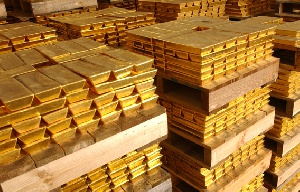Ghana’s mining industry performed reasonably well in 2011, contributing about 40 per cent of total merchandised export during the year, according to a statement from the Ghana Chamber of Mines.
The total mineral revenue of producing member companies of the Chamber rose from $3,724,847,388 in 2010 to $4,778,502,161 in 2011, representing an increase of 28 per cent primarily on account of the increased price of gold and manganese during the period.
Gold revenue increased by 28 per cent from $3,620,766,467 in 2010 to $4,630,255,619 in 2011 due to an increase in the average realised price of gold which appreciated by 30 per cent from $1,219 per ounce in 2010 to $1,583 per ounce in 2011.
Gold production, however, fell by two per cent from 2,970,079 ounces in 2010 to 2,924,385 ounces in 2011. The average aggregated cash cost was $751 per ounce in 2011 compared with the $684 recorded in 2010, an increase of 9.8 per cent.
Mr Dan Owiredu, President of Ghana Chamber of Mines said “The mining industry’s favourable impact on the economy and contribution to the overall growth of the economy and Ghana Revenue Authority’s collections positively stimulated economic activity as the proportion of mineral revenue returned to the country increased appreciably from 68 per cent in 2010 to 75 per cent in 2011.
"In the exercise of its prerogative, government increased taxes and introduced a windfall profit tax. Although government had not clearly defined the details of the proposed windfall profit tax, the sudden announcement did not only adversely affect values of mining stocks held on international bourses but informed some mining companies to hold back some significant investment decisions in the sector.”
Gold Fields Tarkwa Mine maintained its position as the leading producer of gold in Ghana. Operational difficulties led to a marginal decrease in production by about two per cent from 735,034 ounces in 2010 to 717,342 ounces in 2011. This was due to a decrease in Carbon-in-Leach (CIL) throughput as a result of harder ore and frequent interruptions in power supply.
Precious Minerals and Marketing Company’s (PMMC) total purchases and export of gold from small-scale miners decreased by 32 per cent from 346,861 ounces in 2010 to 235,787 ounces in 2011, while PMMC’s exports accounted for only 25 per cent of the volume exported by that segment of the market in 2011.
Asap-Vasa, a wholly Ghanaian-owned gold refinery, exported 10,173 ounces of gold in 2011 compared with 17,133 ounces in 2010 representing a decrease of over 40 per cent over the same period.
On the other hand, Ghana Manganese Company demonstrated a solid 2011 performance with the export of manganese increasing by 53 per cent from 1,193,665 dry tonnes in 2010 to 1,827,692 dry tonnes in 2011.
Understandably, bauxite shipments reduced significantly by 22 per cent from 512,208 tonnes in 2010 to 400,069 tonnes in 2011 leading to a corresponding decrease in export sales from $15,145,755 in 2010 to $13,406,433 in 2011.
The mining sector maintained its position as the leading contributor to Ghana’s revenue collections, accounting for approximately GH¢1.0 billion of revenue collections representing 27.61 per cent of total GRA collections in 2011.
Mining companies continued to meet their company tax obligations which cover corporate tax, withholding tax and levies. This was 38.27 per cent of the total company tax that GRA collected in 2011.
“On this account, the sector maintained its position as the highest contributor of company tax during the year. According to the Minerals Commission, the total investment inflow into the mining sub-sector in 2011 was $780 million; compared to $770 million recorded in 2010,” the statement said.
The mining companies used their repatriations to the country, equivalent to 75 per cent of gross mineral revenue to the country to settle their statutory obligations in the forms of corporate taxes, mineral royalties, and payments of emoluments to employees as well as payments for the supply of local inputs for their operations.
“The mining industry’s enormous contribution to social and economic growth should convince sceptics to rethink their perceptions about the relevance of the industry as a catalyst for development,” says Dr. Toni Aubynn, CEO of Ghana Chamber of Mines.
To underscore its commitment to society, the industry voluntarily contributed about $44 million to its host communities and the general public to support causes that enhanced sustainable development.
In 2012, Ghana’s gold output is expected to increase marginally on the back of fresh production sources coming from Owere Gold Mines, Perseus Mining and Noble Gold Mines.**
Business News of Friday, 8 June 2012
Source: GNA

















